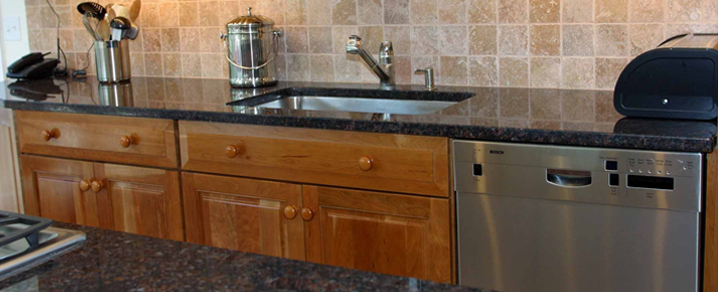Previous Article | Next Article
Choosing Kitchen Counter Top Materials
Confused about choosing a countertop for your new kitchen? Finding the best countertop for the most active room in your home can be a challenge. Here are a few tips that you may find helpful in making a decision.
Laminate
For a tight budget, laminate is a good choice. It is easy to clean and comes in hundreds of colors with many edge treatments. The disadvantages to this material are that chips are not repairable and heat may cause surface burns. Also, it is not suitable to be used as a “cutting board”.
Ceramic Tile
Although not as popular in New England as it is on the west coast, ceramic tile is a good countertop option. It can accommodate any look or budget due to its infinite styles, patterns and colors. Additionally, tile resists heat and moisture. In normal use, it is almost indestructible, although a sharp blow can crack or chip it. But remember, replacing one damaged tile is much easier than replacing a whole countertop. Grout lines that were once difficult to keep clean can now be covered with sealers for easier clean-up. Epoxy-based grouts and dark colored grouts can also make the cleaning process easier. Generally, a bleach-based cleaner used periodically will remove stains and prevent bacteria growth in the grout.
Stone
Stone offers a deluxe appearance, a smooth, cool surface and it is heat-resistant. Choices include marble, quartz, soapstone, and the most popular stone for kitchen countertops, granite. Some stones are more satisfactory for kitchen countertops than others in terms of stain resistance and other important factors. Although beautiful and durable, in general, stone slab is one of the most expensive options. Price will vary according to size, quality and thickness.
One way to achieve the look of stone slab at a lower price is to use stone tiles. For instance, 12″ granite tiles carry all of the same scratch and heat-resistant properties of granite slab and can be set to reduce the size of the grout joints. If you use a darker colored granite with a dark grout, you can come very close to achieving the look of a granite slab countertop at a much lower price. The countertop is finished with a wood or Corian edge.
All natural stone surfaces are porous and must be sealed with a penetrating sealer to keep it from absorbing water and oils. But be aware that even the best sealants cannot protect a granite top from oily messes that are left unattended for hours. For instance, if a stick of butter is allowed to melt on a granite slab counter, it will result in a permanent darkening of the stone where the oil is absorbed. Also, resist the temptation to use a granite countertop as a cutting board. This will dull the polished surface, as well as your knives.
Solid Synthetic Surfaces
These materials, sold under trademarked names including Corian and Avonite, are available in a range of solid colors and stonelike patterns. They are durable, stain-resistant and nonporous. Because these surfaces are solid throughout, scratches, scars and stains can be sanded out. However, these surfaces can scorch from intense heat. The cost of these materials is similar to stone, sometimes slightly less.
Stainless Steel
Stainless Steel provides a unique look. It is seamless, heat-resistant and literally “stainless”. The negatives include scratches, dents and fingerprints. The cost is about the same as synthetic solid surfaces.
Concrete
Concrete can be worked into many shapes and a variety of textures and colors. The results can be industrial or elegant, depending upon the choices made. Although this material is scratch and heat resistant, it stains easily and is prone to cracking. The cost is similar to that of solid synthetic surfaces.

